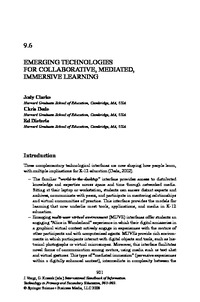Emerging Technologies for Collaborative, Mediated, Immersive LearningZu finden in: International Handbook of Information Technology in Primary and Secondary Education (Seite 901 bis 909), 2009
|
 |
 Diese Seite wurde seit mehr als 9 Monaten inhaltlich nicht mehr aktualisiert. Unter Umständen ist sie nicht mehr aktuell.
Diese Seite wurde seit mehr als 9 Monaten inhaltlich nicht mehr aktualisiert. Unter Umständen ist sie nicht mehr aktuell. Zusammenfassungen
Zusammenfassungen
 Three complementary technological interfaces are now shaping how people learn, with multiple implications for K-12 education (Dede, 2002).
Three complementary technological interfaces are now shaping how people learn, with multiple implications for K-12 education (Dede, 2002).  Dieses Kapitel erwähnt ...
Dieses Kapitel erwähnt ...
 Begriffe KB IB clear | World of Warcraft |
 Anderswo finden
Anderswo finden
 Volltext dieses Dokuments
Volltext dieses Dokuments
 |  Emerging Technologies for Collaborative, Mediated, Immersive Learning: Artikel als Volltext bei Springerlink ( Emerging Technologies for Collaborative, Mediated, Immersive Learning: Artikel als Volltext bei Springerlink ( : :  , 90 kByte; , 90 kByte;  : :  2020-11-28) 2020-11-28) |
 Anderswo suchen
Anderswo suchen 
 Beat und dieses Kapitel
Beat und dieses Kapitel
Beat hat Dieses Kapitel während seiner Zeit am Institut für Medien und Schule (IMS) ins Biblionetz aufgenommen. Beat besitzt kein physisches, aber ein digitales Exemplar. Eine digitale Version ist auf dem Internet verfügbar (s.o.). Aufgrund der wenigen Einträge im Biblionetz scheint er es nicht wirklich gelesen zu haben. Es gibt bisher auch nur wenige Objekte im Biblionetz, die dieses Werk zitieren.










 Biblionetz-History
Biblionetz-History